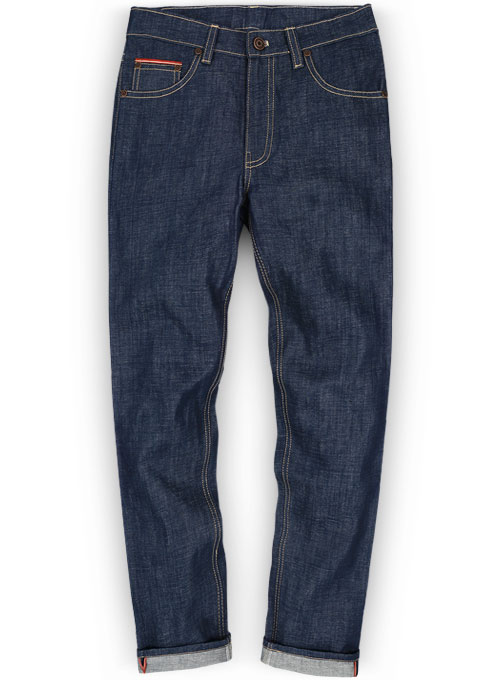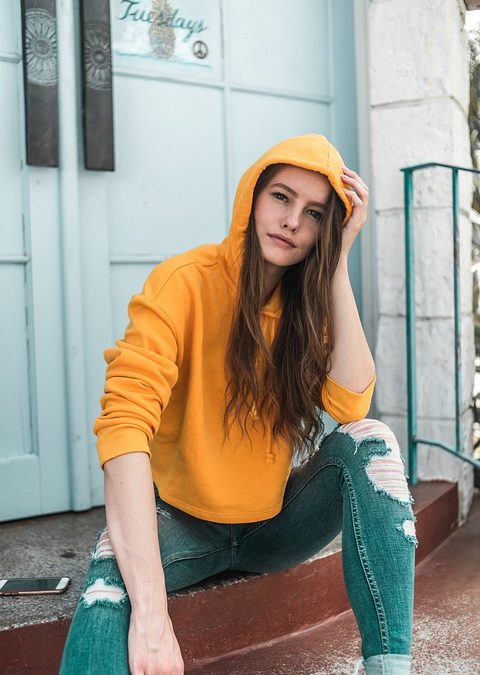Worn by men and women alike, selvedge jeans offer an unparalleled level of quality. They are characterized by a distinct weaving process that creates a tight and narrow band of fabric at the bottom of the pant legs. To the unsuspecting eye, selvedge jeans may look the same as traditional non-selvedge jeans. However, their unique weaving pattern offers several benefits. To learn more about selvedge jeans and why they are so popular, keep reading.
What Are Selvedge Jeans?
Also known as self-edge jeans, selvedge jeans are manufactured using an antique-style loom to create a tight and narrow band of fabric at the bottom of the pant legs. If you look at the photo below, you’ll see a pair of selvedge jeans. The bottom of the jeans features a band of interior fabric — known as a selvedge strip — that’s visible from the outside.
You can easily spot a pair of selvedge jeans by looking for the selvedge strip. Whether you’re shopping online or at a local store, look at the bottom of the pant legs. If you see a narrow band of fabric in a different color or tone than the rest of the denim, the jeans are considered selvedge. If there isn’t a narrow band of fabric at the bottom of the pant legs, on the other hand, the jeans aren’t selvedge.
Some people assume that selvedge jeans are made of a special type of denim, but this isn’t necessarily true. They are still made of the same denim material — which is actually just cotton — as all other jeans. The only exception is stretch selvedge jeans, which are made of denim as well as an elastic fabric like polyester or spandex. Aside from stretch selvedge jeans, all selvedge jeans are made of 100% denim. As a result, you can rest assured knowing they will be comfortable.
Origins of Selvedge Jeans
It’s unknown who was responsible for inventing selvedge jeans. With that said, they were popular until the mid-20th century, during which denim manufacturers switched to industrial looms to speed up the production of their jeans. In the years to follow, selvedge jeans became less popular. Instead, manufacturers focused on mass-producing traditional non-selvedge jeans.
Don’t let that fool you into thinking selvedge jeans are no longer around, however. While most manufacturers use looms that create wide fabric, some still use vintage-style looms to create selvedge jeans. In recent years, selvedge jeans have made a comeback. Regardless of where you live, you’ll probably see more men and women wearing these highly stylish jeans.
How Much Fabric Is Needed to Make Selvedge Jeans
Because selvedge jeans feature narrower fabric, they require more denim to produce than traditional non-selvedge jeans. Here at MakeYourOwnJeans, for example, we use about 3 yards of additional fabric to make selvedge jeans. The narrow nature of selvedge jeans means they require more material to produce than traditional non-selvedge jeans.

Selvedge Jeans Don’t Unravel
One of the reasons selvedge jeans are making a comeback is because they are naturally protected against unraveling. The selvedge strips at the bottom of the pant legs prevent the denim material from unraveling.
It’s frustrating when you’re wearing a pair of jeans, only to discover that the bottom of the pant legs won’t stay up. Many people fold the bottom of their pant legs up a few inches to prevent them from dragging on the ground. If your jeans drag on the ground, they’ll likely develop torn and frayed fabric, which is difficult to repair. Selvedge jeans prevent this from happening by securing the bottom of your jeans in place. The selvedge strips essentially hold the denim in place, thereby preventing your jeans from unraveling.
Selvedge Jeans Are Stylish
Another benefit of selvedge jeans is their stylish appearance. With the bottom of the pant legs folded up, the selvedge strips will become visible. Why does this matter exactly? Well, both the interior lining of selvedge jeans, as well as the selvedge strips themselves, feature a different color than the exterior of the jeans.
In terms of appearance, the difference between selvedge jeans and non-selvedge jeans is subtle. Nonetheless, most people will agree that selvedge jeans are more stylish than their counterparts. The visible band of denim material around the bottom of the pant legs introduces a new element that’s not found in other jeans.
How to Choose Selvedge Jeans
If you’re going to invest in a pair of selvedge jeans, you need to choose the right type. First and foremost, consider the color and whether it’s aligned with the rest of your clothes. If you purchase a pair of selvedge jeans in a bold color, you may struggle to incorporate them into your daily outfits. But if you choose a pair of selvedge jeans in a common color, such as indigo or light blue, you’ll be able to wear them on a daily basis.
Aside from the color, you should consider the cut when choosing a pair of selvedge jeans. Like other jeans, selvedge jeans are available in a wide range of cuts, some of which include skinny, straight leg, low rise, high rise, boyfriend, loose, relaxed and baggy. Each cut is designed to fit in a different way.
If you prefer the soft and elastic properties of stretch denim over traditional denim, consider purchasing a pair of stretch selvedge jeans. As previously mentioned, stretch selvedge jeans feature the same narrow construction as other selvedge jeans. The only difference is that they are made of both denim as well as an elastic fabric.
After reading this, you should have a better understanding of selvedge jeans. Also known as self-edge jeans, they feature a tight and narrow band of fabric. The purpose of this band of fabric is to prevent the jeans from unraveling while also creating a unique style. So, if you’re tired of wearing the same basic jeans day after day, maybe it’s time to upgrade your wardrobe by investing in a pair of selvedge jeans.











